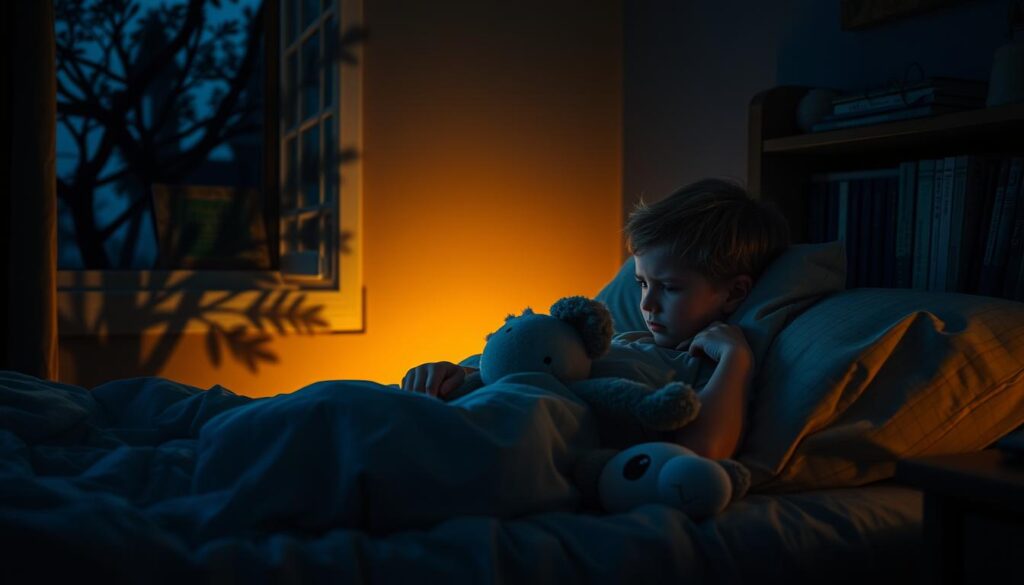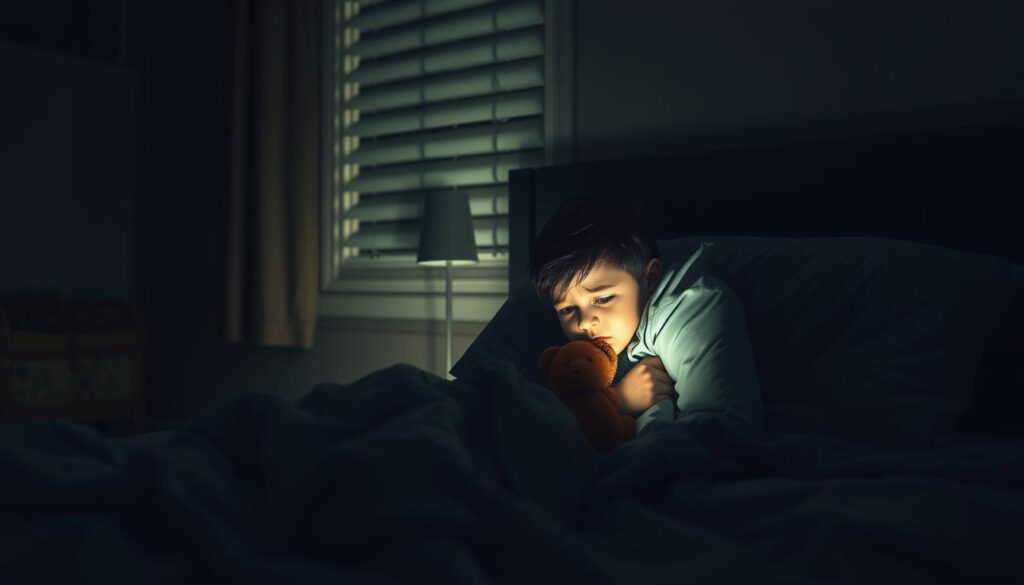Do you often find yourself wondering why your child’s anxiety spikes at night, turning bedtime into a challenging battle? You’re not alone. Many parents face this issue, and it’s more common than you might think.
Up to 30% of children experience nighttime anxiety at some point, which can disrupt their sleep and affect their overall well-being. As a parent, it can be heartbreaking to see your child struggle with racing thoughts and fears that seem manageable during the day but intensify at night.
The good news is that there are effective ways to address these issues. The Lunesia Story Approach has helped countless families transform bedtime into a special bonding opportunity, empowering children to develop healthy sleep habits and emotional regulation skills.
Understanding Nighttime Anxiety in Children
As a parent, understanding nighttime anxiety in children is crucial for helping them develop healthy sleep habits. Nighttime anxiety refers to the intensification of anxious thoughts, physical tension, and restlessness that occur in the evening or before sleep. Unlike general anxiety, which can manifest throughout the day, nighttime anxiety often centers around overthinking, racing thoughts, and an inability to relax before bed.
Causes of Nighttime Anxiety
Nighttime anxiety in children can stem from various sources, including developmental fears, major life changes, exposure to scary media content, or an overactive imagination. Children with certain temperaments may be more prone to anxiety disorders, with research showing that approximately 7-9% of children will experience an anxiety disorder that affects their sleep. Understanding these causes is essential for addressing the root of the issue.
- Major life changes, such as starting school or moving, can trigger nighttime anxiety.
- Exposure to scary media content can fuel an overactive imagination, leading to nighttime anxiety.
- Children with certain temperaments are more prone to anxiety disorders.
Recognizing the Signs
It’s essential to recognize the signs of nighttime anxiety in children, which can include physical symptoms like stomachaches, headaches, and increased heart rate, as well as behavioral signs like bedtime resistance, frequent night wakings, and nightmares. By understanding these signs, parents can identify when their child is experiencing nighttime anxiety and take steps to address it.
- Physical symptoms include stomachaches, headaches, and increased heart rate.
- Behavioral signs include bedtime resistance, frequent night wakings, and nightmares.
- Seeking reassurance through questions or needing a parent present to fall asleep are common behaviors.
How Nighttime Anxiety Affects Children’s Sleep and Development
Nighttime anxiety can significantly impact children’s sleep patterns and overall development. As a parent, it’s essential to understand this complex relationship to help your child overcome nighttime fears and establish healthy sleep habits.

The Sleep-Anxiety Cycle in Children
The sleep-anxiety cycle is a vicious loop where anxiety disrupts sleep, and poor sleep worsens anxiety symptoms the next day. This cycle typically begins with physical symptoms like a racing heart and stomach butterflies, making relaxation difficult and leading to negative thoughts about sleep itself. Over time, children may develop a conditioned response where bedtime becomes a trigger for anxiety, creating a self-perpetuating cycle that’s challenging to break.
Children need 9-12 hours of sleep for their developing bodies and minds. When anxiety disrupts their sleep, it can affect their concentration, memory formation, and emotional regulation during the day. This can lead to difficulties in school and social relationships, making it crucial to address nighttime anxiety early.
Long-term Effects of Untreated Nighttime Anxiety
If left untreated, nighttime anxiety can have long-term effects on children’s health and development. It can increase the risk of developing more serious anxiety disorders or depression in adolescence and adulthood. Chronic sleep issues related to anxiety can also affect a child’s growth, as important growth hormones are primarily released during deep sleep phases.
The good news is that addressing nighttime anxiety early can prevent these long-term effects. By establishing healthy sleep patterns and reducing anxiety, parents can help their children develop resilience and improve their overall well-being. It’s crucial for parents to be proactive in addressing nighttime anxiety to ensure their child’s healthy development and quality of life.
Introducing the Lunesia Story Approach

I’ve developed the Lunesia Story Approach as a way to help children overcome their bedtime fears. This method combines elements of cognitive behavioral therapy with the ancient tradition of storytelling, creating a powerful tool for reducing nighttime anxiety.
What is the Lunesia Story Approach
The Lunesia Story Approach is a structured method that uses specially crafted stories to address the specific mechanisms of anxiety in children’s developing brains. Unlike generic bedtime stories, Lunesia stories are designed with therapeutic elements that help children process fears, reframe anxious thoughts, and develop healthy mental associations with nighttime.
Each Lunesia story follows a specific pattern that gradually shifts a child’s focus from anxiety-producing thoughts to calming imagery and positive sleep associations. This approach works by engaging multiple sensory pathways in the brain, creating new neural connections that associate bedtime with safety rather than fear.
How Lunesia Stories Help Reduce Nighttime Anxiety
Lunesia stories incorporate evidence-based relaxation techniques woven naturally into engaging narratives that children actually look forward to hearing. The stories are designed to empower children to become active participants in managing their own anxiety rather than passive recipients of comfort.
Research in pediatric mental health supports the use of narrative therapy for anxiety conditions, showing that stories can help children externalize their fears and develop healthier thought patterns. By using the Lunesia Story Approach, parents can help their children develop a positive association with sleep and reduce nighttime anxiety.
The Lunesia Story Approach can be customized to address specific fears (darkness, separation, etc.) while maintaining the core therapeutic structure that makes it effective for reducing nighttime anxiety. By consistently using Lunesia stories, parents can help their children develop healthy sleep habits and improve their overall mental health.
Creating the Perfect Bedtime Environment
The bedroom environment plays a vital role in either exacerbating or alleviating nighttime anxiety in kids. As a parent, creating a sleep sanctuary that signals to your child’s body and mind that it’s safe to relax and transition to sleep is crucial.
Setting Up a Calming Sleep Space
To establish a calming sleep space, consider the sensory factors that impact your child’s sleep quality. Ensure the bedroom is cool, with a temperature between 65-70°F (18-21°C), as this range is optimal for children’s sleep. Additionally, invest in comfortable bedding and pajamas, avoiding scratchy tags or lumpy mattresses that can trigger physical discomfort and feed into anxiety.
Avoid exposure to blue light from screens before bed, as it can delay melatonin production by up to 90 minutes. Making your child’s bedroom an electronics-free zone can significantly improve their sleep.
Establishing a Consistent Bedtime Routine
Developing a predictable bedtime routine is powerful because it creates a series of cues that prepare your child’s nervous system for sleep, gradually downshifting from the day’s excitement. The ideal routine should follow the same sequence each night and last about 30-45 minutes, giving your child’s body time to produce natural sleep hormones.
For more guidance on establishing a bedtime routine, you can explore resources like Lunesia’s bedtime routine for 10-year-olds or learn about quick bedtime routines that can help your child wind down effectively.
It’s also essential to avoid giving children food or drinks containing caffeine at least 6 hours before bedtime, as their bodies process it more slowly than adults. Consistency is key; research shows that children with regular bedtime routines fall asleep faster, experience fewer night wakings, and report lower levels of nighttime anxiety overall.
Implementing the Lunesia Story Approach: Step-by-Step Guide
The Lunesia Story Approach offers a structured method to help children overcome nighttime anxiety through storytelling. By following a simple framework, parents can effectively use this approach to calm their child’s anxiety and improve their sleep.
Choosing the Right Lunesia Story
Selecting the appropriate Lunesia story is crucial as it directly addresses your child’s specific anxiety triggers. Whether your child fears monsters, separation, or has racing thoughts that make falling asleep difficult, there’s a story designed to help. I recommend exploring the available stories on the Lunesia app to find the one that best suits your child’s needs.
The Ideal Timing and Setting
Timing is crucial when using the Lunesia approach. I suggest beginning the story about 20 minutes before your child’s ideal sleep time. This allows their mind to transition gradually from wakefulness to drowsiness. Creating the right atmosphere is also vital; dim lighting, comfortable positioning, and eliminating distractions help your child focus on the narrative.
Engaging Your Child with Interactive Storytelling
Unlike passive storytelling, the Lunesia approach involves gentle interaction that keeps your child engaged. As you tell the story, use a normal conversational tone initially and gradually shift to a slower, softer voice. This voice modulation signals to your child’s brain that it’s time to wind down. The three-phase structure of Lunesia stories—acknowledgment, transformation, resolution—helps children process their anxiety night fears within a safe narrative framework.
| Phase | Purpose | Effect on Child |
|---|---|---|
| Acknowledgment | Recognizes the child’s fears | Feels understood and validated |
| Transformation | Transforms the fear into a positive outcome | Builds hope and reduces anxiety |
| Resolution | Resolves the fear, promoting calm | Prepares the child for sleep |
Consistency is key when using the Lunesia Story Approach. Regular use, not just on “bad nights,” helps rewire your child’s associations with bedtime and builds their capacity to self-soothe when anxious thoughts arise. By incorporating this approach into your bedtime routine, you can help your child develop resilience against nighttime anxiety and improve their overall sleep quality.
Complementary Relaxation Techniques for Reducing Nighttime Anxiety
Combining the Lunesia Story Approach with relaxation techniques provides a comprehensive toolkit for managing nighttime anxiety in children. Nighttime anxiety can lead to restlessness, a racing heart, and overall distress for children. By incorporating relaxation techniques into their bedtime routine, parents can help their children relax and prepare for a restful night’s sleep.
Child-Friendly Breathing Exercises
Breathing techniques are a simple yet effective way to calm the mind and body. Child-friendly breathing exercises can help slow down a child’s heart rate and reduce anxious feelings. One effective method is the “Balloon Breath,” where children imagine inflating a balloon with each inhale and watching it float away with each exhale. For school-aged children, a simplified version of box breathing (inhale-hold-exhale-hold) can be taught using visual cues like tracing a square with their finger.
Deep breathing works by activating the body’s relaxation response, lowering heart rate and blood pressure while sending signals to the brain that it’s safe to relax. Regular practice of these breathing exercises can help children develop better coping mechanisms for anxiety.
| Breathing Technique | Description | Benefits |
|---|---|---|
| Balloon Breath | Imagine inflating a balloon with each inhale and watching it float away with each exhale | Reduces anxiety, promotes relaxation |
| Box Breathing | Inhale-hold-exhale-hold, using visual cues like tracing a square | Slows heart rate, calms the mind |
Progressive Muscle Relaxation for Kids
Progressive Muscle Relaxation (PMR) is another effective technique for reducing nighttime anxiety. By systematically tensing and relaxing different muscle groups, children can release physical tension and feel more relaxed. The “Spaghetti Test” is a fun way to practice PMR, where children pretend to be stiff, uncooked spaghetti that gradually softens into relaxed, cooked noodles.
Starting with their feet and moving up to their calves, thighs, stomach, shoulders, and jaw, children can tense each muscle group for a few seconds before releasing. This helps them become more aware of their body and release tension.
Guided Imagery and Visualization
Guided imagery taps into children’s natural imaginative abilities, redirecting their thoughts from anxiety-producing scenarios to calming mental landscapes. The “Magic Carpet Ride” visualization is particularly effective, guiding children to imagine floating on a magic carpet above their worries, visiting peaceful places where they feel safe and happy.
By regularly practicing these relaxation techniques, children can develop the skills they need to manage nighttime anxiety and improve their overall sleep quality.
Addressing Specific Nighttime Fears Through Storytelling
By using targeted narratives, parents can help their children navigate and overcome specific nighttime fears. I’ve developed specific storytelling frameworks for the most common nighttime fears children experience, each with unique narrative elements designed to address particular anxiety triggers.
Monsters and Darkness: Stories That Help
Monster fears typically peak between ages 2-6 and stem from children’s developing ability to imagine threats combined with their difficulty distinguishing fantasy from reality. The most effective monster stories don’t deny the possibility of monsters but transform them from threatening figures into misunderstood or even helpful characters, giving children a sense of control over their fear. For instance, a story about a friendly monster who becomes a child’s protector can be very comforting.
Separation Anxiety: Comforting Tales for Bedtime
Children experiencing separation anxiety at bedtime benefit from stories featuring characters who discover they’re never truly alone, with themes of invisible connections that remain even when physically separated. The “Always Connected” story technique uses tangible symbols (like matching stuffed animals or special blankets) that appear in the narrative and then transition into real objects the child can keep with them. This technique helps children feel more secure and connected to their parents.
Worry and Overthinking: Calming Stories for Busy Minds
For children with racing thoughts and worry at bedtime, stories with repetitive, rhythmic elements help slow down mental activity and interrupt the cycle of overthinking that can trigger panic at night. The “Thought Balloon” narrative technique teaches children to visualize their racing thoughts as balloons they can gently release, incorporating this metaphor into stories they can later use as a self-soothing technique.

The most powerful aspect of targeted storytelling is that it gives children a vocabulary and framework for understanding their anxiety, making an abstract, frightening experience more concrete and manageable. By addressing specific nighttime fears through storytelling, parents can help their children develop resilience and improve their sleep quality.
When to Seek Professional Help for Your Child’s Nighttime Anxiety
Understanding when to seek professional help for your child’s nighttime anxiety is crucial for their mental health and well-being. While the Lunesia Story Approach can be beneficial for many children, there are instances where nighttime anxiety may be a symptom of a more serious underlying issue.
Warning Signs That Require Professional Attention
If your child is experiencing any of the following, it may be time to consult a mental health professional:
- Persistent panic attacks during the night
- Anxiety that persists despite consistent intervention
- Significant impairment in daytime functioning due to nighttime anxiety
- Physical symptoms like stomachaches or headaches that don’t resolve with home-based approaches
It’s essential to recognize that some anxiety disorders, such as separation anxiety disorder or generalized anxiety disorder, can first manifest as nighttime anxiety in children. If you notice any signs that worry you, seeking professional help can provide your child with the support they need.
Types of Professional Support Available
Several types of professional support can help children manage nighttime anxiety:
- Cognitive-Behavioral Therapy (CBT): Pediatric psychologists specializing in CBT can help children address underlying anxiety issues.
- Play Therapy: Effective for younger children, play therapy allows them to express their fears in a therapeutic environment.
- Family Therapy: When a child’s anxiety affects the entire household, family therapy can provide valuable support and guidance.
Seeking professional help is not a sign of failure; it’s a proactive step towards ensuring your child’s mental health and well-being. By recognizing the warning signs and understanding the types of support available, you can make informed decisions about your child’s care.
Conclusion: Building Resilience Through Storytelling
By harnessing the power of storytelling, the Lunesia Story Approach provides a unique solution to the complex issue of nighttime anxiety in children. Throughout this guide, we’ve explored how this approach can transform bedtime from a source of stress into an opportunity for connection and emotional growth.
The techniques we’ve discussed, from creating a calming sleep environment to implementing progressive muscle relaxation and breathing exercises, work together to address both the physical and psychological causes of nighttime anxiety. By using the Lunesia Story Approach, parents can help their children develop resilience that serves them throughout life.
Research consistently shows that children who learn to manage anxiety early develop stronger emotional regulation skills, better stress responses, and higher quality sleep patterns that benefit their mental health into adulthood. The parent-child bond strengthened through nighttime storytelling creates positive bedtime associations that can replace anxiety with feelings of security and comfort.
While helping your child overcome difficult sleep and anxiety night issues is a journey, consistent application of these techniques will help most children fall asleep more peacefully over time. If your child continues to struggle, don’t hesitate to reach out to a mental health professional who specializes in childhood anxiety.
My hope is that the Lunesia Story Approach will not only help your child fall asleep more easily but also equip them with valuable emotional tools they’ll carry with them long after they’ve outgrown their childhood fears.
FAQ
What is the Lunesia Story Approach and how does it help children with nighttime anxiety?
The Lunesia Story Approach is a method that uses storytelling to help children overcome nighttime anxiety. By engaging your child in calming and imaginative stories, you can help them relax and fall asleep more easily.
How can I create a bedtime environment that promotes relaxation and reduces anxiety?
To create a calming sleep space, consider dimming the lights, maintaining a comfortable temperature, and minimizing noise. Establishing a consistent bedtime routine can also help signal to your child that it’s time to sleep.
What are some child-friendly relaxation techniques that can help with nighttime anxiety?
Techniques like deep breathing exercises, progressive muscle relaxation, and guided imagery can be adapted for children. These methods can help your child relax and prepare for sleep.
How do I know if my child’s nighttime anxiety requires professional help?
If your child’s nighttime anxiety persists, interferes with their daily life, or is accompanied by other concerning symptoms, it may be necessary to seek professional help. A mental health professional can provide guidance and support to address underlying issues.
Can the Lunesia Story Approach be used in conjunction with other relaxation techniques?
Yes, combining the Lunesia Story Approach with other relaxation techniques, such as deep breathing or progressive muscle relaxation, can enhance its effectiveness in reducing nighttime anxiety.
How long does it take to see results from using the Lunesia Story Approach?
The time it takes to see results can vary depending on your child’s individual needs and circumstances. Consistency and patience are key when implementing this approach.




